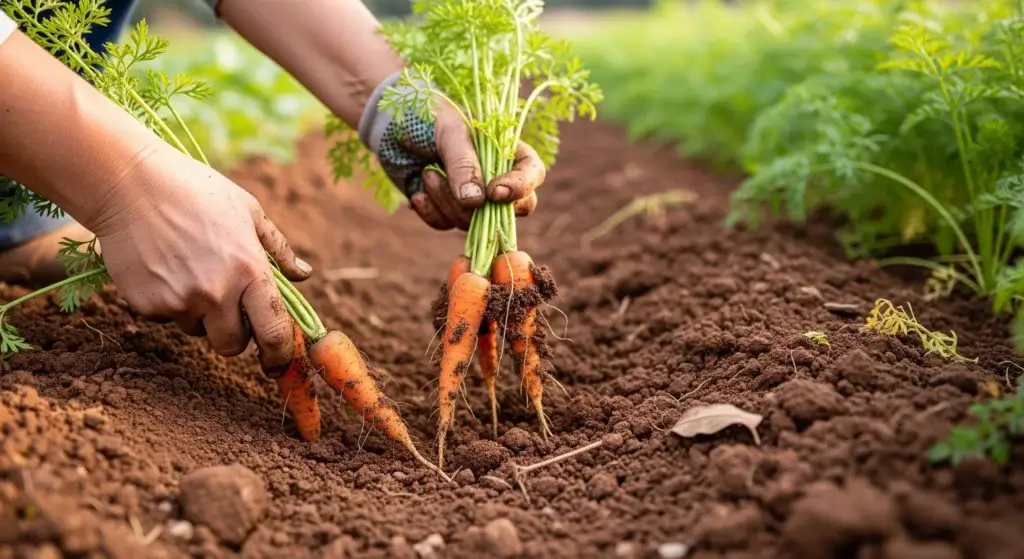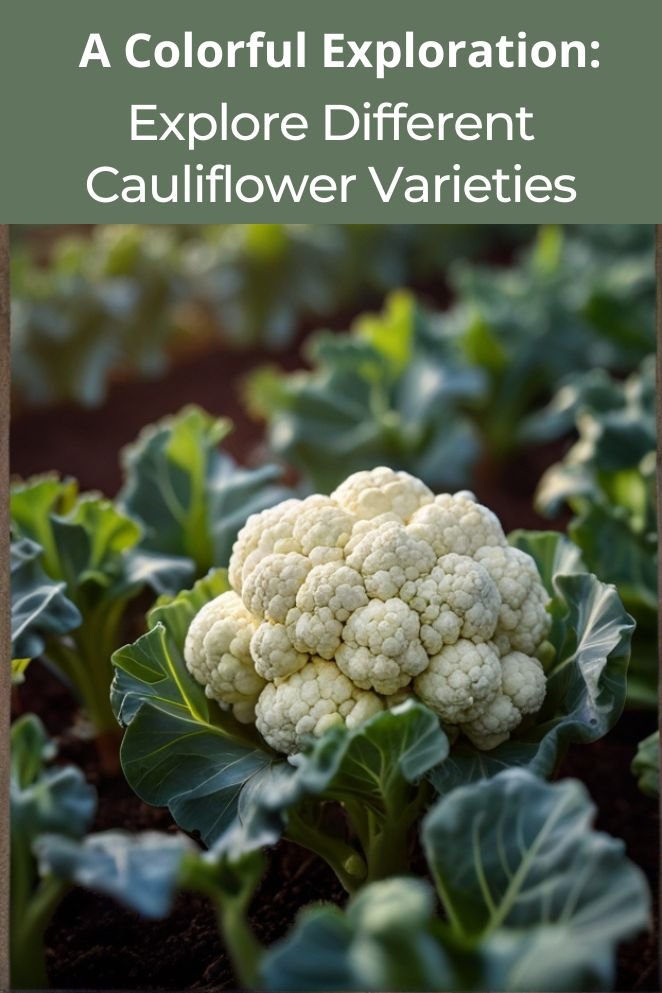
This versatile vegetable has evolved far beyond its familiar white form.
Today, cauliflower offers a delightful array of colors and flavors to tantalize your taste buds.
In this extensive guide, we’ll explore the diverse landscape of cauliflower varieties, guiding you toward the ideal choice for your next kitchen experiment.
About Cauliflower
Cauliflower belongs to the Brassicaceae family, also known as the mustard family.
Other members of this family include broccoli, cabbage, kale, and Brussels sprouts.
Cauliflower thrives in moderate weather conditions, with ideal temperatures around 60-70°F .
They are not frost-tolerant and will bolt (flower prematurely) if exposed to hot weather.
Here are characteristics of cauliflower plants:
- Read also: Taming the Curd: Identifying Common Cauliflower Problems
- Read also: Attracting Pollinators for a Bountiful Cauliflower Harvest
Leaf structure
Cauliflower plants have large, broad, blue-green leaves with waxy coating.
The leaves have lobed margins and prominent veins.
Head (curd)
The most interesting characteristic of cauliflower plants is the curd, which is the edible part of the plant.
The curd is actually a cluster of immature flower buds that have been tightly packed together to form a dense, white (or orange, purple depending on the variety) head.
Thick stalk
Cauliflower plants have a thick, sturdy stalk that supports the large head and leaves.
Shallow root system
Cauliflower plants have a shallow root system, making them susceptible to drought stress.
They require consistent moisture throughout the growing season.
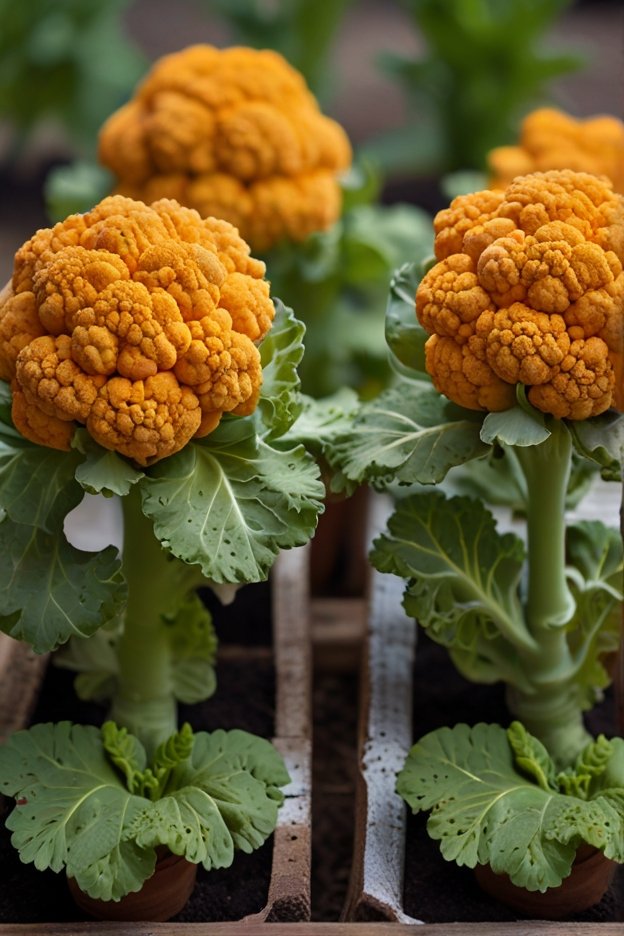
Types of Cauliflower Plants
Cauliflower comes in a variety of colors, each with its own distinct characteristics.
Here are some of the most common types:
White cauliflower
White cauliflower is the most common and widely recognized variety. It has a creamy white head, which is the edible portion of the plant.
This type of cauliflower has a mild, slightly sweet flavor and a tender texture when cooked.
There are many varieties of white cauliflower available, each with slightly different characteristics:
- Early maturing varieties: These varieties mature in 50-60 days and are ideal for spring or fall planting. Examples include ‘Snow Crown’ and ‘White Rocket’.
- Mid-season maturing varieties: These varieties take 60-70 days to mature and are well-suited for summer planting in cooler climates. Examples include ‘Snowball’ and ‘Silverado’.
- Late maturing varieties: These varieties mature in 70-80 days and are best for fall planting in areas with mild winters. Examples include ‘Winter Snowball’ and ‘Freedom’.
Orange cauliflower
Orange cauliflower, also known as cheddar cauliflower, gets its vibrant hue from beta-carotene, the same antioxidant found in carrots.
Orange cauliflower offers a slightly sweeter flavor compared to white cauliflower.
Here are some of the common orange cauliflower varieties you might encounter:
- Cheddar cauliflower: This variety is named for its vibrant orange florets that resemble the color of cheddar cheese. It holds its color well even when cooked, making it a visually striking addition to dishes.
- Orange burst cauliflower: This variety has a slightly milder orange color compared to Cheddar cauliflower. It’s known for its sweet, nutty flavor and tender texture.
- Orange bouquet cauliflower: This variety boasts a beautiful, deep orange color throughout its head. It has a similar flavor profile to other orange cauliflower varieties but with a slightly more floral note.
Purple cauliflower
The color comes from anthocyanins, powerful antioxidants also found in blueberries, raspberries, and red cabbage.
In terms of flavor, purple cauliflower is similar to white cauliflower but may have subtle earthy undertones.
Here are some popular varieties of purple cauliflower:
- Sicilian violet: This heirloom variety from Italy is known for its deep purple florets and strong, slightly bitter flavor. It matures in the late summer to early fall and is a favorite among chefs.
- Violet queen: This variety produces large heads with a vibrant violet color. It has a milder flavor compared to Sicilian Violet and is well-suited for both raw and cooked applications.
- Purple cape: This variety features medium-sized heads with a rich purple color. It’s known for its good flavor and tight florets, making it a versatile choice for cooking.
- Graffiti: This visually striking variety boasts purple florets with white speckles, resembling graffiti art. It has a mild, slightly sweet flavor and holds its color well when cooked.
Green cauliflower
Green cauliflower, also known as broccoflower, is a hybrid of broccoli and cauliflower, characterized by its green heads and sweet taste.
Green cauliflower contains chlorophyll which gives it a green color.
It is characterized by its green heads and green leaves, and it has a mild, sweet, and subtly nutty flavor without the bitter undertones commonly associated with white cauliflower varieties.
While not as widely available as white cauliflower, there are a few green cauliflower varieties you might encounter:
- Green stem cauliflower: This variety is sweeter, more tender, and more heat-tolerant than standard cauliflower varieties. It has somewhat loose curds on long, green stems and is great for dipping and quick kitchen prep.
- Broccoflower: Also known as green cauliflower, it is a hybrid variety resulting from the cross between broccoli and cauliflower. Green cauliflower is available year-round, with a peak season in mid-winter through early spring
Romanesco cauliflower
Romanesco cauliflower, also known as Romanesco broccoli or broccoflower, is a distinct variety with a fractal-shaped appearance.
Its flavor is similar to broccoli but slightly earthier.
Romanesco cauliflower is not a hybrid of broccoli and cauliflower, but rather a cultivar of cauliflower (Brassica oleracea var. botrytis) that boasts a truly mesmerizing form.
There are a few romanesco cauliflower varieties you might encounter:
- Romanesco cauliflower (Romanesco broccoli or broccoflower): Romanesco is known for its intricate, mathematical pattern and crunchy texture, making it a unique and visually appealing vegetable.
- Veronica: This is a romanesco cauliflower known for its lime green, pointy florets and good heat tolerance.
Mini cauliflower
Since “mini cauliflower” is a general term, there are many cultivars that fall under this category.
Seed companies often develop their own mini cauliflower varieties, so specific names may vary.
However, some commonly available options include:
- Snowball mini: This variety produces compact white heads around 4-5 inches (10-12 cm) in diameter and matures in about 50 days.
- Cheddar cauliflower mini: This miniature version of the orange cauliflower boasts vibrant orange florets in a head size of 3-4 inches (7.5-10 cm).
- Purple cauliflower mini: Similar to purple cauliflower varieties, these miniature versions have beautiful purple florets in a compact head size.
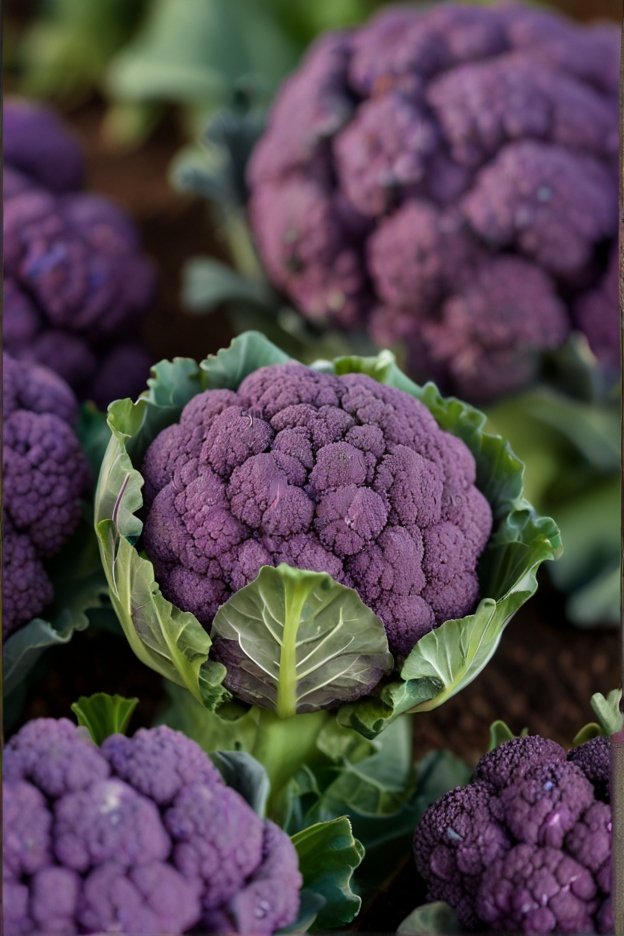
Choosing the Perfect Cauliflower Variety for Your Garden
Selecting the ideal cauliflower cultivar for your garden is crucial for a successful harvest.
Various factors come into play when making this decision, ensuring that your choice aligns with your garden’s conditions and your culinary preferences.
Let’s delve into the key considerations to help you make the best choice:
Climate
Cauliflower is a cool-season vegetable. Different cauliflower varieties have specific temperature tolerances.
- Early vs. mid vs. late season planting: Depending on your climate and desired harvest time, you’ll need to choose a variety suited for early, mid, or late-season planting. Early varieties mature faster and are ideal for cooler spring or fall weather. Mid-season varieties take a bit longer and are suited for longer spring or moderate summer climates. Late-season varieties tolerate cooler temperatures and are best for fall planting in areas with mild winters.
- Bolting: Consider your region’s average temperatures. Bolting refers to premature flowering in response to stress, often triggered by hot weather. Choose varieties with good bolt resistance if you have hot summers.
Choose cauliflower varieties that thrive in your region and are resistant to common issues you may encounter.
Garden space
Standard cauliflower plants can grow quite large. If you have limited space, consider mini cauliflower varieties that are bred for compact growth and smaller head sizes.
These are also perfect for container gardening.
Harvest preferences
Think about when you’d like to harvest your cauliflower.
Early maturing varieties take around 50-60 days, while late maturing varieties can take up to 80 days.
Choose a variety that fits your desired harvest window.
Head characteristics
- Color preference: Do you have a preference for white, orange, purple, or green cauliflower? Each variety offers a slightly different flavor profile and visual appeal.
- Head size: Standard cauliflower heads can reach 6-8 inches (15-20 cm) in diameter. If you prefer smaller heads for single servings or limited space, consider mini cauliflower varieties.
Disease resistance
Some cauliflower varieties are more resistant to common diseases like clubroot or downy mildew.
Consider this factor if these diseases are prevalent in your area.
Seed availability
Not all varieties are readily available at all seed stores.
Check with your local nurseries or seed companies to see what options they offer.
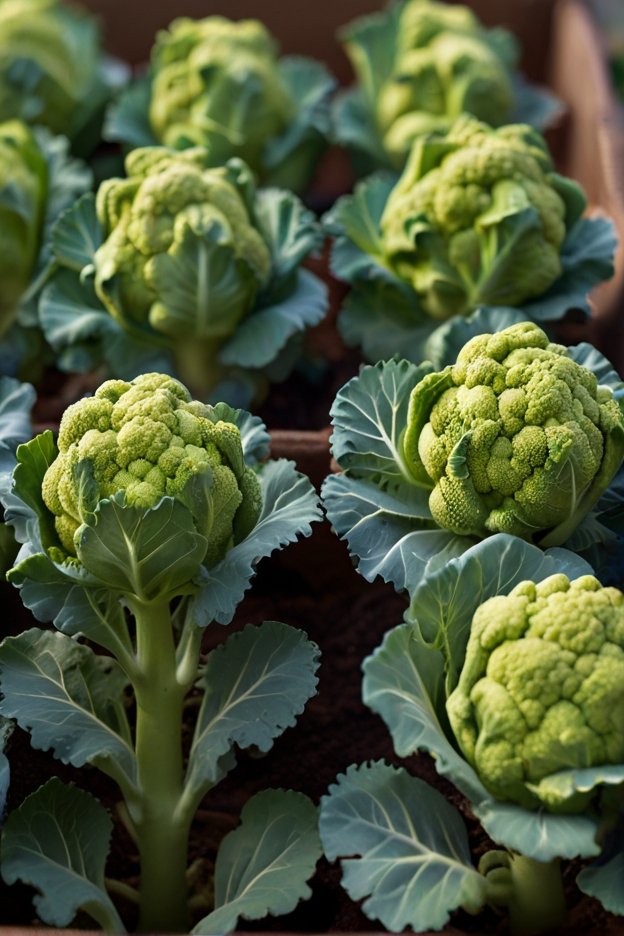
- Read also: Tips and Tricks: A Guide to Watering Your Cauliflower Plants
- Read also: Cauliflower Powerhouse: The Nutrient Riches For Cauliflower
Conclusion
The world of cauliflower cultivation offers a rich tapestry of colors, flavors, and textures to explore.
From the familiar white varieties to the vibrant oranges, purples, and greens, there’s a cauliflower cultivar to suit every garden and palate.
Whether you opt for early, mid, or late-season varieties, or choose compact mini cauliflowers for limited spaces, the diverse array of options ensures that there’s something for everyone.
By selecting the ideal cauliflower cultivar tailored to your preferences and growing conditions, you can embark on a flavorful journey from garden to table, enriching your culinary adventures with this nutritious vegetable.
FAQs
Nope! Colored cauliflower varieties like orange and purple are the result of natural mutations and selective breeding, not genetic modification.
Both are green, but Romanesco cauliflower is easily identified by its stunning fractal-shaped head. Regular green cauliflower has a similar appearance to white cauliflower but with lime green to deep forest green florets.
Consider your climate, garden space, desired harvest time, and preferred head size and color. Early maturing varieties are ideal for cooler seasons, while late maturing varieties tolerate cooler temperatures. Mini cauliflower is a good choice for limited space.

